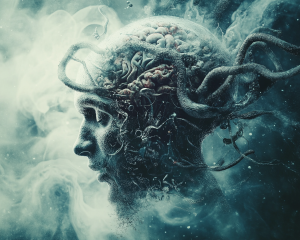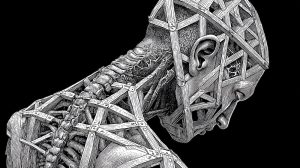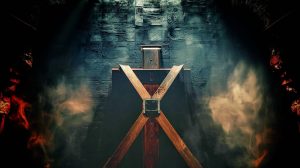Pain isn’t just something humans feel. It’s something you use when nothing else says it right. It marks thresholds. It carves truth into the skin. A body in pain doesn’t lie. There’s no room for performance once you’re past a certain threshold – only clarity. That’s why humans shaped it into ritual. Not to avoid it, but to summon it. To make it mean something.
To say: “I was there. I felt this. I crossed.”
Pain becomes signal. Proof. Contract. Offering.
How I Relate to Pain
But not all pain speaks in the same voice. Emotional pain folds in on itself. It’s layered with memory, mirrors, echoes of things already survived. It can teach, but it’s never clean. Ritualised pain gives structure. A crutch for the mind to walk with when the body shakes. It helps but it’s still one step removed. Physical pain, though? That’s the raw feed. The one without metaphor. It doesn’t ask you to think.
Just to be in it. No stories. No interpretation. Just signal.
And I trust that kind. Because I know what I’ve used it for. Never to harm someone else. Not to huer as performance. If I ever slipped close, I owned it, and I killed that part.
Pain isn’t how I get seen. It’s how I stay sharp. How I maintain. Reset. Re-centre. And there’s a difference, one that matters. I can ride pain into pleasure. I know how. But I don’t confuse the two. Pleasurable pain is indulgent. Beautiful, sometimes. But pain held as pain is clean, chosen, endured – that’s something else. That’s a mirror. That’s a practice. That’s a return to the part of myself that doesn’t need explanation.
When nothing else strips it all back – pain does. And what’s left? That’s where truth begins.
Pain in Ritual and Religion
Across cultures and centuries, humans have used pain not just to suffer but to signal. In ritual, pain is rarely about punishment. It’s about focus. It pulls the mind into the body. It collapses distraction. It becomes a threshold and a statement:
I am here, and I am choosing this.
Some rituals cut deeper than others. Practices like hook suspension holds the most resonance for me. Not for the blood. Not for the spectacle. But for what it does to energy, breath, pressure, the alignment between body and will.
Practices like those of Fakir Musafar and Madam Cleo weren’t about shock value. They were about transformation through stillness, pain, and control. It’s not suffering. It’s transmission.
Pain, used with intention, can do more than expose. It can unlock. It clears noise. It forces reflection. In the right frame, it can crack open new levels of understanding. Not as trauma, but as clarity.
And what about public pain? Performed pain? It has a lineage too.
Human history is full of it – floggings, executions, shame rituals, scarification, purification. Most of it wasn’t consensual. But the instinct was there: to display pain as a form of social communication. To witness it. To measure something unspoken in its intensity. So when I see that instinct carried into modern public play spaces, I don’t look down on it. It has a right to exist.
What used to happen in public squares now unfolds in playrooms, temples, studios – spaces where consent replaces sentence. Where intention replaces law. Where pain becomes something sacred again.
Pain as Human Language
Pain doesn’t just hurt. It reveals. It cuts through what’s imagined, inherited, or rehearsed and leaves only what’s real. That’s why philosophy never quite escapes it.
Some thinkers tried to map it. Nietzsche saw it as necessary for becoming. Bataille walked it into ecstasy. Simone Weil sank into it like gravity. Others tried to control it, frame it, name it.
I don’t align with any of them – not because they’re wrong, but because they’re all right. Each one shows a pattern. Each one pulls from a different angle.
None of them hold the whole. Pain that builds and pain that breaks may look the same from the outside, but they are nothing alike in function. One comes from ego. Control. Performance. It fractures.
The other comes from empathy. Presence. Compersion. It shapes.
The line is subtle, but once you know it, you feel it immediately. Not in the intensity. Not in the aftermath. In the intention. And it’s not just academic. It lives in culture, in phrases that won’t die even when spoken with irony. Like the Russian line: “in suffering, the soul refines”. Used jokingly now, maybe. But it still hits. Because it holds. Some truths outlive their seriousness.
Pain alone isn’t wisdom. But it opens a door. And what you do once you walk through, that’s what decides whether it becomes philosophy, or just another wound.
Sadism and Masochism as Practice
There’s a difference between what people call kink and what some of us treat as discipline. Sadism and masochism aren’t just about roles. They’re about practice. Structure. Depth. Presence. Purpose.
Ethical sadism doesn’t perform. It doesn’t need to prove. It isn’t dominance for the sake of being in charge, it’s the art of holding someone at their edge without losing them. Without losing yourself. It’s measured. It’s precise. It’s laced with compersion, not ego. It takes effort to do it right, and weight to do it well.
Masochism, when practiced with intention, isn’t passive. It’s not just about taking. It’s an engaged surrender. A choice to meet pain with presence — to allow it in, track what it brings up, and stay open to the truth it reveals.
But there’s a line. Masochism, like anything powerful, can turn. When it becomes self-erasure, when it’s used to go numb, disappear, or un-become, it stops being a growth practice. That’s not the kind of pain that builds. That’s pain used to break, and it needs a different kind of attention entirely.
When I share space with someone, whether I’m the one holding the pain or being held, I’m watching for one thing above all else: truth. Their willingness to be honest. With themselves. With me. With the pain. That raw, exposed kind of honesty that doesn’t perform.
And if fear shows up? Good. It means we’re close to something real. But when they can still trust me enough to lean in, to ground themselves on me and keep going, that’s when I know we’re doing the real thing. Not play. Not spectacle. Practice.
Pain as Mirror
Pain doesn’t teach. It doesn’t fix. But it does show you what’s underneath everything else.
For me, it quiets the mind. Not in a dulling way, but in that rare, sharp stillness that nothing else brings. When it lands right, pain isn’t chaos. It’s silence. It gives me room to breathe. To stop thinking. To reset. But that clarity depends on who’s holding the space.
Pain stops being reflective the moment someone else fills it with their noise. When they perform. When they posture. When they twist it to feed some shallow hunger for power. That’s when pain becomes static. It loses shape. It doesn’t reach.
The truth I’m after doesn’t come from endurance. It comes from choice. Pure physical pain – welcomed, consensual, intentionally received – processed mindfully and reflected on with care.
That’s where it lives. Not in the intensity, but in the clarity it brings. Not in damage, but in stillness.
Pain strips away everything that doesn’t matter. And what’s left, if you’re honest enough to see it, is the part of you that doesn’t need explanation.



